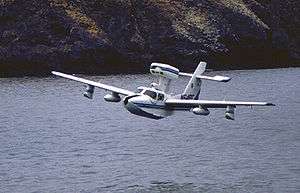Lake Renegade
| Renegade, Seafury, Seawolf | |
|---|---|
 | |
| Seawolf operated by NOAA | |
| Role | Utility amphibian |
| National origin | United States |
| Manufacturer | Lake Aircraft |
| First flight | 1982 |
| Developed from | Lake Buccaneer |

The Lake LA-250 Renegade is a six-seat amphibious utility aircraft produced in the United States by Lake Aircraft since 1982.[1]
Design and development
The Renegade is a lengthened and more powerful version of the Lake Buccaneer. They share the Buccaneer's type certificate, and Buccaneer production was terminated.[2] In turn, it gave rise to a number of variants, including the militarised LA-250 Seawolf, the turbocharged LA-270 Turbo Renegade, and the LA-270 Seafury optimised for marine environments.[1][2] Like the Buccaneer, it is a conventional mid-wing design with retractable tricycle undercarriage and a single engine mounted in pusher configuration in a pod on a pylon above the fuselage.[3]
The Seawolf version was designed for light maritime patrol duties and features a hardpoint under each wing to carry external stores, including bombs, rocket pods, gun pods, or rescue equipment.[3] Provision for a radar unit was made on the forward end of the engine pod.[3][4] The Seafury includes improved anti-corrosion measures and a hardened interior to improve its serviceability in saltwater environments, as well as a storage compartment carrying survival gear.[5]
Operational history
In 1988 Peter Foster and Robert Mann piloted a Turbo Lake Renagade to an altitude of 24,500 feet, setting a new world record for altitude and sustained flight at altitude for single-engine seaplanes.[6]
Variants
- LA-250 Renegade — Buccaneer with 38-inch (97-cm) fuselage stretch, six seats, and Lycoming IO-540-C4B5 engine
- LA-250 Seawolf — militarised Renegade with hardpoints and provision for radar
- LA-270 Turbo Renegade — Renegade with Lycoming TIO-540-AA1AD engine uprated to 270 hp (200 kW)
- LA-270 Seafury — Renegade for saltwater conditions
Specifications (LA-250)
Data from Jane's All the World's Aircraft 1984–85, 431 and The Incomplete Guide to Airfoil Usage[7]
General characteristics
- Crew: one pilot
- Capacity: five passengers
- Length: 28 ft 4 in (8.64 m)
- Wingspan: 38 ft 0 in (11.58 m)
- Height: 10 ft 0 in (3.05 m)
- Wing area: 170 ft2 (15.8 m2)
- Wing profile: NACA 4418 (root), NACA 4412 (tip)
- Empty weight: 1,850 lb (839 kg)
- Gross weight: 3,050 lb (1,383 kg)
- Powerplant: 1 × Lycoming IO-540-C4B5, 250 hp (186 kW)
Performance
- Maximum speed: 160 mph (258 km/h)
- Range: 1,036 miles (1,668 km)
- Service ceiling: 14,700 ft (4,480 m)
- Rate of climb: 900 ft/min (4.6 m/s)
Notes
References
- Jane's All the World's Aircraft 1984–85. London: Jane's Publishing.
- Simpson, R. W. (1995). Airlife's General Aviation. Shrewsbury: Airlife Publishing.
- Taylor, Michael J. H. (1989). Jane's Encyclopedia of Aviation. London: Studio Editions.
External links
| Wikimedia Commons has media related to Lake Renegade. |